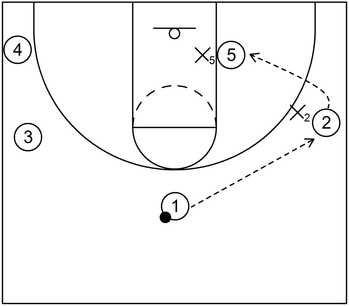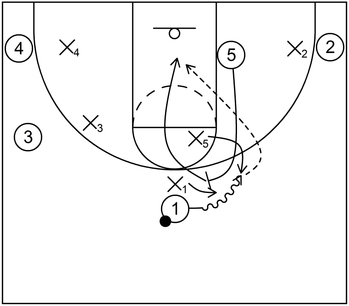What is the wrap around pass
The wrap around pass consists of offensive action in which a player in possession of the basketball throws it around an opposing defender to a teammate, ultimately leading to a possible scoring opportunity or an additional playmaking option.
Why is the wrap around pass potentially beneficial
The wrap around pass is potentially beneficial because it could be used as a counter to defensive pressure, especially when the possible receiver of the wrap around pass is near the basket for a scoring opportunity.
For example, let’s say that a player has possession of the ball near the perimeter and that same player is currently being guarded heavily by a certain on-ball defender with active hands.
At the same time, let’s say that the another player without the ball gets open via a basketball cut straight to the rim.
From that point, if the player with the ball attempts to execute a specific type of basketball pass such as a chest pass, then there is at least a small, if not moderate chance that the pass would be deflected or intercepted by the defender with active hands.
Instead, for this instance, the player that has possession of the ball could throw it around the defender in such a manner that the ball could not be deflected or intercepted.
Afterwards, it would be possible for the receiver of the wrap around pass to score at the rim with a layup or dunk.
What are the types of wrap around passes
The types of wrap around passes are the stationary wrap around pass and the dribble wrap around pass.
It should be noted as well that each type of wrap around pass could be executed as an air pass, particularly if the defender’s hands are low or a bounce pass, generally if the defender’s hands are high.
Stationary wrap around pass
When executing a stationary wrap around pass, the offensive player in possession of the ball usually begins in the triple threat position.
Following that, the player with the ball will use their non-pivot foot to step around the adjacent on-ball defender and afterwards, that same player would then throw the ball, usually with one hand, to the potential receiver.
To give a brief example of this process, let’s say that a player with the ball is being guarded by an on-ball defender near the right side wing and that same player would like to throw the ball to a teammate near the right side low post block.
From that point, that same player could use their left foot to step around the adjacent on-ball defender and throw the ball, with their right hand, to the teammate near the low post block.
Dribble wrap around pass
The dribble wrap around pass is essentially a variation of the standard dribble pass.
To execute the dribble wrap around pass, the offensive player will initially dribble the basketball, usually towards the basket via dribble penetration, and then throw it around a defender when the opportunity presents itself.
As an example of this, let’s say that an offensive player in possession of the ball dribbles toward the basket and that same player is also being guarded by an on-ball defender with high and active hands, primarily to hinder potential passing options as well as to contest a possible jump shot if necessary.
At the same time, let’s say a secondary offensive player without the ball cuts directly to the basket from a perimeter area of the court.
Following that, the player in possession of the ball could throw it around the on-ball defender to the cutting teammate who could then score at the rim.
What are simple example diagrams of the wrap around pass
Example 1

This is an example of the stationary wrap around pass utilized to get the ball into the hands of the team’s best low post player.
To start, 2 receives the ball from 1 and immediately following that, X2 implements maximum on-ball defensive pressure so that 2 cannot easily throw the ball to 5 via post entry action.
As a counter to that pressure, 2 should swiftly pick up their left foot, sweep it (and the ball) across both feet of X2, and then place that same left foot near the left side of X2.
Afterwards, 2 should position the ball near their right hip and then use their right hand to throw the ball to 5 via an air pass or bounce pass.
From that point, 5 could use a low post move against X5 to score near the rim.
Also, it should be mentioned as well that, in this instance, 2 could step laterally with their right foot towards the right side corner, similar to a jab step.
That would basically create a bit of separation between 2 and X2, which then allows 5 the opportunity to receive the ball via the wrap around pass by 2.
However, this lateral step alteration might not be as ideal as the step around version because X2 could potentially deflect the pass, particularly with their left hand, or even possibly slide into the passing lane to intercept the pass.
Yet, if 2 does decide to execute the lateral step variation, it is probably better to perform a fake pass before executing the actual wrap around pass.
Example 2

This is an example of a dribble wrap around pass used during pick and roll action. To begin, 1 attempts to dribble towards the basket by way of the on-ball screen set by 5.
However, X5 tries to limit the possible dribble penetration by executing a defensive soft hedge while X1 fights over the top of the screen to chase after 1.
Also, for this demonstration, let’s assume that both X3 and X4 erroneously forget to execute help defense from the weak side. As a result, let’s say that this particular defensive mistake gives 5 an opportunity to freely roll to the basket unopposed.
From there, 5 receives the ball via the wrap around pass (i.e. the ball was thrown around X5) by 1 and then scores at the rim via a layup or dunk.